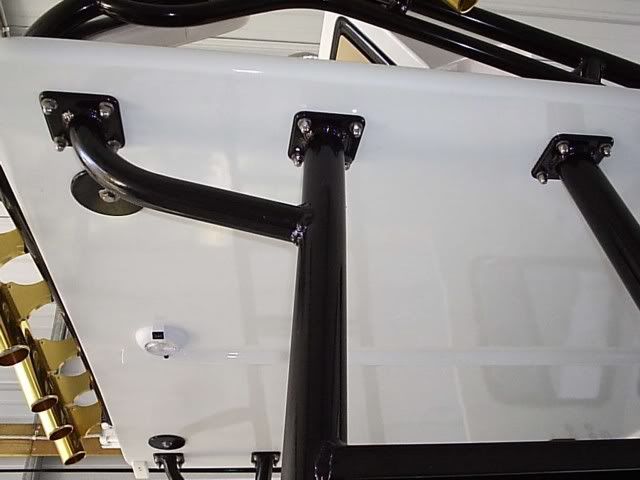Sal:
What are you going to hold? The reason I ask this is that you could drill through just the frp and not have the drill or fastener go through the carpeting. But ... this method would be limited by the weight of the object you're going to hold AND the forces from the seas the object will be subject to. Some tips ...
Drilling fiberglass or "frp", fiberglass reinforced plastic:
1) It is always advisable to "step up" in drill size when drilling holes > 1/8" and always use a variable speed drill.
2) After you chuck up the drill you're going to use, put the drill into REVERSE and slowly wear a slight dish into the glass where the drill will go through. Remember, gelcoat is 3-10X more brittle than frp and it tends to fracture or chip if you dig right in and the cutting edge of the drill grabs the material.
3) Once you've dished out a dent in the glass roughly equal to the drill diameter, switch back to Forward and drill through. Always back off your pressure here and there to allow the drill bit to clear itself of chips.
4) What I do and recommend, is now go in with a countersink and make a c'sink just over the diameter of the hole I am going to end up with. Makes all subsequent drilling go fast and you'll never have a chipping problem.
5) If in an area you really don't want to chance screwing up ... you could apply 3M blue tape over the glass first.
Self-Tapping Screws:
You could use these to drill through the bulkhead but NOT have the point of the screw extend through or into the carpet. A few CRITICAL points here though ...
1) If you do it this way - drill size of the hole is very important. You must go through with a drill where the drill diameter is a hair larger than the BODY size of the screw ... not > then that threaded part or teeth part, but the body size. If you were to hold a size 10 screw up to the light away from you, you would see that the body looks to be < 1/8" in diameter, but around the teeth part, it's probably 3/16" to almost 1/4". If you attempt to put a self-tapping screw into a too small hole ... it WILL break off! Yeah, I've done it and yes, I've removed the broken stub with a dremel tool and yes, it was a mess and I needed to re-gelocat the surrounding area.
2) Now, take your screw and cut it down so that it's overall length would allow it to go through the item it will hold and the thickness of the bulkhead and maybe another 1/16" or more for good measure. Better too long, you can always cut it down ... "removal" tools work much better than "add on" tools for metal working, hehe.
3) Put some candle wax onto the threads as a lubricant. Slowly attempt to drive the screw in. If it binds, step up one size in a the drill, or use a Dremel tool and small cutter to ever so slightly expand the hole without cutting into the carpet.
4) Once I'm sure I have the right size hole and my screw length is right, I make sure the screw has lube on it, I use a good screwdriver with a good (non-worn!) tip, I lean into it and I start installing it. I use the technique like tapping metal, go in 1/2-turn or more, then back off a touch, and then another 1/2-turn and repeat.
5) Note, no self-tapping screw will ever hold the amount of weight or bear the same amount of force that a through bolt will withstand. But, they can be a cosmetically superior alternative in the right application.
Through Bolt:
Drill through the glass like 1st part above. Getting through your carpet can be tricky.
1) No real tricks but try not to use the drill. It will grab the threads and it could twist it or create a thread pull ... and then you'll have a permanent scar. I had best results on the "fake fur" interior that my old Pro-Line had by using an icepick and making a small hole and then gradually forcing it larger.
2) An exacto knife can also be used to cut a hole.
3) When tightening the nut, make sure that the washer or item being held doesn't rotate, as that action too could cause a ripple in the carpet.
4) What I do on nylok nuts, the self-locking ones with the little clear/white ring on the top (that's all you should ever use on a boat) is simply "snap" off the extra thread by using an intentionally too-long bolt and then grabbing the excess with vice grips, and then giving it 2-3 good quick rocking twists to snap off the excess. Do it quick and fast so that you only impart force to the exposed threads and not to the bolt going through the glass. If still sharp, I just dress the top of the nut with a file.
Whew ... that's me, that's how I do it, but I am sure there are other methods and tips out there. Sal, don't worry about drilling into the boat, you have other worries as a new Parker owner to worry about ... like hitting the dock too hard

!








